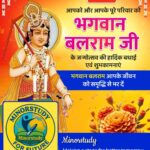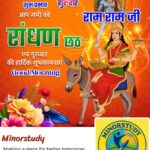Kamarchath (Halashashti) Festival – History, Facts, Significance & Daily Life Impact
Kamarchath—also known as Halashashti, Halchhath, Harchhath, or Chandrashashti—is a deeply revered festival from Chhattisgarh, celebrated with devotion by mothers across villages and urban communities alike. Typically observed on the sixth day (Shashthi) of Krishna Paksha in the month of Bhadrapada, Kamarchath is a heartfelt ritual where mothers fast to invoke divine blessings for their children’s longevity, health, and strength.
History & Origins
The roots of Kamarchath trace back to ancient Dwapar Yuga, where Devaki—mother of Lord Balarama and Krishna—faced the sorrow of losing six children at the hands of King Kansa. To protect her seventh child, she performed Shashthi Mata’s worship, and the divine blessings led to the birth of the mighty Balarama, endowed with health and strength. Since then, this festival has been observed by mothers seeking similar blessings for their offspring.
Timeline & Ritual Flow
| Phase | Details |
|---|---|
| Date | 6th day of Krishna Paksha in Bhadrapada (after Raksha Bandhan) |
| Morning Rituals | Mothers bathe, observe a full or partial fast, often called Halashashti Vrat. |
| Afternoon Setup | In courtyard or communal area, mothers dig two small pits called Sagari (like symbolic ponds). |
| Decor & Offerings | Bring from home terracotta toys, miniature plough, Shiva/Gauri idols—all placed at the edge of Sagari. Then add buffalo milk, curd, ghī, local flowers (e.g., Mahua), grains (Lai, Pashar rice), and Bel leaves. |
| Stories & Devotion | Mothers listen to six Shashthi Mata stories, followed by arti. |
| Breaking the Fast | They refrain from using wheat or plough-based grains; instead eat Pashar rice, six types of vegetables, buffalo milk products; then apply tilak and sandalwood paste near the children’s shoulder/waist for blessings. |
| Conclusion | Mothers break their fast with prasad, distribute offerings like popped grains, roasted Mahua, legumes, symbolizing community sharing. |
Fascinating Facts
Alternate Names: Known across regions as Halashashti, Kamarchath, Halchhath, or Chandrashashti.
Buffalo Milk Ritual: In contrast to the cultural supremacy of cow’s milk, this fast emphasizes buffalo milk, seen as potent for strength and vitality—and symbolically linked to longevity.NPG News
Sagari Symbolism: The two pits called Sagari signify life and fertility—filled with offerings that honor deities and nature.
Sixfold Significance: Mothers use six kinds of vegetables, distribute six types of prasad, and narrate six stories—reinforcing the theme of holistic blessings.
Connection to Balarama: This festival overlaps with Balarama Jayanti—the birth anniversary of Lord Balarama, known for his strength and protector role.
Regional Parallel to Chhath: Similar to Bihar’s Chhath Puja in sentiment, Kamarchath also centers around child protection and well-being.
Significance & Societal Impact
Maternal Love in Action: This ritual beautifully captures a mother’s wish and effort to shield her children through symbolic and sacred means.
Community Bonding: Shared preparation of Sagari, rituals, and distribution of prasad reinforces neighborhood unity and mutual support.
Cultural Identity: Kamarchath stands as a bright cultural thread in Chhattisgarh’s social fabric, preserving oral histories (like the six tales) and primitive offerings.
Agricultural & Natural Respect: Emphasis on naturally derived food—Pashar rice, Mahua, etc.—celebrates local biodiversity and sustainable practices.
Spiritual & Emotional Healing: The festival offers emotional solace to mothers, channeling anxiety over child welfare into collective, faith-filled action.
Daily Life Impacts
Preserving Tradition: Continuation of these rituals encourages younger generations to value their culture and ancestors’ practices.
Empowering Women: As central to the ceremonies, mothers experience spiritual agency—celebrating both devotion and responsibility.
Promoting Natural Diets: Usage of local grains and buffalo dairy in fasting promotes awareness of regional and wholesome nutrition.
Strengthening Community Bonds: Mother-led gatherings nurture networks of emotional and logistical support in neighborhoods.
FAQs
Q1: What is Kamarchath?
A: A Chhattisgarhi festival (also Halashashti) where mothers fast for their children’s long life and well-being.
Q2: When is it observed?
A: On the sixth day of Krishna Paksha in Bhadrapada, shortly after Raksha Bandhan.
Q3: Why buffalo milk and Pashar rice?
A: Buffalo milk is valued for vigor and longevity; Pashar rice—grown without tilling—symbolizes purity and strength.
Q4: What is Sagari?
A: Two decorative, symbolic pits dug by mothers to host idols and offerings for the ritual ceremony.
Q5: How is it different from Bihar’s Chhath Puja?
A: Both are child-focused rituals, but Kamarchath includes unique local customs: Sagari, six vegetable rule, buffalo dairy, and Shashthi storytelling.
Wishing Messages for Kamarchath
“Wishing you a joyous **Kamarchath! May your children be blessed with strength, health, and long life.”
“Happy Kamarchath! May this sacred day surround your home with love, protection, and enduring blessings.”
Conclusion
Kamarchath is a stirring testament to maternal devotion, cultural vibrancy, and spiritual resilience. Through its beautifully symbolic rituals—Sagari construction, use of buffalo milk, special grains, storytelling, and communal acts—it beautifully conveys the hope, love, and protective strength of motherhood. Beyond rituals, it strengthens community bonds, preserves ancient traditions, and honors the power of natural life. In embracing its essence, each Kamarchath celebration becomes a heartfelt affirmation: that life—nurtured with devotion—is strengthened and uplifted.








